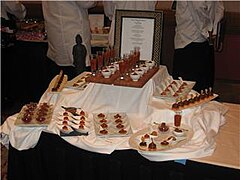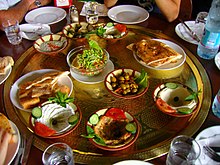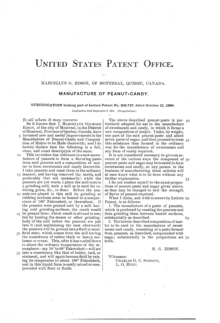Breakfast buffet of Japanese and Western-style breakfast foods at Nishimuraya Shogetsutei in Kinosaki Onsen, Japan (2011)
A buffet is a system of serving meals in which food is placed in a public area where the diners serve themselves.[1] A form of service à la française, buffets are offered at various places including hotels, restaurants,
and many social events. Buffet restaurants normally offer
all-you-can-eat food for a set price, but some measure prices by weight
or by number of dishes. Buffets usually have some hot dishes, so the
term cold buffet (see Smörgåsbord) has been developed to describe formats lacking hot food. Hot or cold buffets usually involve dishware and utensils, but a finger buffet
is an array of foods that are designed to be small and easily consumed
only by hand, such as cupcakes, slices of pizza, foods on cocktail
sticks, etc.
The essential feature of the various buffet formats is that the
diners can directly view the food and immediately select which dishes
they wish to consume, and usually also can decide how much food they
take. Buffets are effective for serving large numbers of people at once,
and are often seen in institutional settings, business conventions, or
large parties.
Home entertaining
Since
a buffet involves diners serving themselves, it has in the past been
considered an informal form of dining, less formal than table service.
In recent years, however, buffet meals are increasingly popular among
hosts of home dinner parties, especially in homes where limited space complicates the serving of individual table places.
Origins
Swedish smörgåsbord buffet
In the 19th century, supper, a lighter meal some hours after the main dinner,
was sometimes served as a buffet (and so called), especially late at
night at grand balls, where not everyone present would want to eat, or
at the same time, or in the same quantity. Even in a very large
building, at a large ball there might not be enough space to seat all
guests at the same time, or servants to serve them in the manner
required by the prevailing customs. A large cooked English breakfast
with various choices was also very often routinely served this way, for
similar reasons. Even when many servants were on hand, there might be
an element of self-service. The term buffet originally referred to the French sideboard furniture where the food was placed, but eventually became applied to the serving format.
At balls, the "buffet" was also where drinks were obtained, either by circulating footmen
supplying orders from guests, but often by the male guests. During the
Victorian period, it became usual for guests to have to eat standing
up. In fact John Conrade Cooke's cookbook Cookery and Confectionery, (London: 1824) says it was already "the present fashion".
In a report on a ball in 1904, a departure from "the usual stand-up
buffet supper", with parties being able to reserve tables, was praised.
Scandinavians like to claim that the buffet table originates from the brännvinsbord (Swedish schnapps, or shot of alcoholic beverage) table from the middle of 16th century. This custom had its prime during the early 18th century. The smörgåsbord buffet did not increase in popularity until the expansion of the railroads throughout Europe.
The smörgåsbord table was originally a meal where guests
gathered before dinner for a pre-dinner drink, and was not part of the
formal dinner that followed. The smörgåsbord buffet was often held in separate rooms for men and women before the dinner was served.
Smörgåsbord became internationally known as "smorgasbord" at the 1939 New York World's Fair exhibition, as the Swedes had to invent a new way of showcasing the best of Swedish food to large numbers of visitors.
As displays of wealth
Modern sideboard furniture, used for serving food
While the possession of gold and silver has been a measure of solvency of a regime, the display of it, in the form of plates and vessels, is more a political act and a gesture of conspicuous consumption. The 16th-century French term buffet
applied both to the display itself and to the furniture on which it was
mounted, often draped with rich textiles, but more often as the century
advanced the word described an elaborately carved cupboard surmounted
by tiers of shelves. In England, such a buffet was called a court cupboard. Prodigal displays of plate were probably first revived at the fashionable court of Burgundy and adopted in France. The Baroque displays of silver and gold that were affected by Louis XIV of France were immortalized in paintings by Alexandre-François Desportes
and others, before Louis' plate and his silver furniture had to be sent
to the mint to pay for the wars at the end of his reign.
During the 18th century, more subtle demonstrations of wealth
were preferred. The buffet was revived in England and France at the end
of the century, when new ideals of privacy made a modicum of self-service at breakfast-time appealing, even among those who could have had a footman servant behind each chair. In The Cabinet Dictionary of 1803, Thomas Sheraton presented a neoclassical
design and observed that "a buffet may, with some propriety, be
restored to modern use, and prove ornamental to a modern breakfast-room,
answering as the china cabinet/repository of a tea equipage."
20th century
Dinner buffet in Americus Hotel (1955)
In a 1922 housekeeping book entitled How to Prepare and Serve a Meal, Lillian B. Lansdown wrote:
The concept of eating a buffet arose in mid 17th century France, when gentleman callers would arrive at the homes of ladies they wanted to woo unexpectedly. Their surprise arrival would throw the kitchen staff into a panic and the only food that could be served was a selection of what was found in the cold room.
The informal luncheon or lunch — originally the light meal eaten between breakfast and dinner, but now often taking the place of dinner, the fashionable hour being one (or half after if cards are to follow) — is of two kinds. The "buffet" luncheon, at which the guests eat standing; and the luncheon served at small tables, at which the guests are seated...
The knife is tabooed at the "buffet" lunch, hence all the food must be such as can be eaten with fork or spoon. As a rule, friends of the hostess serve... The following dishes cover the essentials of a "buffet" luncheon. Beverages: punch, coffee, chocolate (poured from urn, or filled cups brought from pantry on tray); hot entrées of various sorts (served from chafing dish or platter) preceded by hot bouillon; cold entrées, salads, lobster, potatoes, chicken, shrimp, with heavy dressings; hot rolls, wafer-cut sandwiches (lettuce, tomato, deviled ham, etc.); small cakes, frozen creams and ices.
The informal luncheon at small tables calls for service by a number of maids, hence the "buffet" plan is preferable.
Variations
A small cold buffet at an art school exhibition
There are many different ways of offering diners a selection of foods
that are called "buffet" style meals. Some buffets are "single pass
only", but most buffets allow a diner to first take small samples of
unfamiliar foods, and then to return for more servings if desired. To
avoid misunderstandings in commercial eating establishments, the rules
and charges are often posted on signs near the buffet serving tables.
- One form of buffet is to have a display counter or table filled with plates containing fixed portions of food; customers select plates containing whichever dishes they want as they walk along. The food display may either be staffed, or the customers may pick up the food plates themselves. This form is most commonly seen in cafeterias. Another derivative of this type of buffet occurs where patrons choose food from a buffet style layout and then pay based on what was chosen (sometimes based on the weight of the food, or color-coded plates).
- A variation occurs in a dim sum house, where seated patrons make their selections from wheeled carts containing different plates of food which the staff circulate through the restaurant. Another variation is a conveyor belt sushi restaurant, where seated patrons select dishes from a continuously-moving conveyor belt carrying a variety of foods. In another variation, Brazilian rodízio style buffets feature roving waiters serving churrascaria barbecued meats from large skewers directly onto the seated diners' plates.
- The "all-you-can-eat" buffet is more free-form; customers pay a fixed fee and then can help themselves to as much food as they wish to eat in a single meal. This form is found often in restaurants, especially in hotels. In some countries, this format is popular for "Sunday brunch" buffets.
- A so-called Mongolian barbecue buffet format allows diners to collect various thinly-sliced raw foods and add flavorings, which are then stir-fried on a large griddle by a restaurant cook.
- Some hot pot restaurants offer all-you-can-eat buffets, in which diners order plates of thinly-sliced raw foods and flavorings, and cook them in boiling pots of soup at their tables.
- A salad bar is commonly offered in delicatessens and supermarkets, in which customers help themselves to lettuce and other salad ingredients, then pay by weight. Sometimes only cold foods are offered, but often warmed or hot foods are available at a "hot foods bar", possibly at a different price by weight.
- Open buffets are often associated with a celebration of some sort, and there may be no explicit charge or the cost may be included in an admission fee to the entire event. Art show openings at galleries and museums are often accompanied by a modest buffet for invited guests.
As a compromise between self-service and full table service, a
staffed buffet may be offered: diners carry their own plate or tray
along the buffet line and are given a portion by a server at each
station, which may be selected or skipped by the diner. This method is
prevalent at catered meetings where diners are not paying specifically
for their meal.
Alternatively, diners may serve themselves for most prepared selections, but a carvery station for roasted meats is staffed. Some buffet formats also feature staffed stations where crepes, omelettes, noodle soups, barbecued meats, or sushi are custom prepared at the request of individual diners.
All-you-can-eat
The all-you-can-eat restaurant was introduced in Las Vegas by Herbert "Herb" Cobb McDonald in 1946.
Many boarding schools, colleges, and universities offer optional or mandatory "meal plans", especially in connection with dormitories for students. These are often in an "all-you-can-eat" buffet format, sometimes called "all-you-care-to-eat" to encourage dietary moderation. The format may also be used in other institutional settings, such as military bases, large factories, cruise ships, or medium-security prisons.
In 2007, the first all-you-can-eat seating section in Major League Baseball was introduced at Dodger Stadium. The trend spread to 19 of the 30 major league parks by 2010, and numerous minor league parks by 2012. The basic menu includes traditional ballpark food such as hot dogs, nachos, peanuts, popcorn, and soft drinks. In 2008 all-you-can-eat seats were also inaugurated in numerous NBA and NHL arenas.
Buffet etiquette
There
are a few formal and informal rules for safe and courteous dining at
buffets. Especially if repeat visits to the serving stations are
permitted, diners are expected not to take too much food at one time, to
avoid unnecessary food waste.
Some all-you-can-eat buffet restaurants have a "per plate" charge
policy to discourage customers from wasting excessive amounts of food.
Other buffet restaurants do not charge for extra food servings, but do
impose a surcharge for food that is taken but not eaten by a customer.
Diners should not re-use plates and utensils when getting additional servings, and observe basic food hygiene rules.
Restaurant buffets
A small Chinese American buffet selection
North Indian-style buffet
Most buffets offer water and other soft drinks without limit, but charge extra for alcoholic drinks.
In Australia, buffet chains such as Sizzler
serve a large number of patrons with carvery meats, seafood, salads and
desserts. Cruise operators in Sydney, conduct Sydney Harbour
sightseeing cruises with continental buffets having multiple seafood
options. Buffets are also common in Returned and Services League of Australia (RSL) clubs and some motel restaurants.
In Brazil, comida a quilo or comida por quilo —
literally, "food by [the] kilo" — restaurants are common. This is a
cafeteria style buffet in which diners are billed by the weight of the
food selected, excluding the tare weight of the plate. Brazilian cuisine's rodízio style is all-you-can-eat, having both non-self-service and self-service variations.
In Hong Kong, the cha chaan teng buffet is a relatively new variation on traditional low-cost Chinese snack and coffee shops.
In Japan, a buffet or smorgasbord is known as a viking (バイキング - baikingu). It is said that this originated from the restaurant "Imperial Viking" in the Imperial Hotel, Tokyo,
which was the first restaurant in Japan to serve buffet-style meals.
Dessert Vikings are very popular in Japan, where one can eat from a
buffet full of desserts.
In Sweden, a traditional form of buffet is the smörgåsbord, which literally means "table of sandwiches".
United States
In the US, there are numerous Chinese-American cuisine-inspired buffet restaurants, as well as those serving primarily traditional American fare. Also, South Asian cuisine (notably in Indian restaurants), pan-Asian cuisine, and Mediterranean cuisine are increasingly available in the buffet format, and sushi has also become more popular at buffets. In some regions of the US, Brazilian-style churrascaria barbecue buffets served rodízio style are becoming popular.
Las Vegas and Atlantic City are famous for all-you-can-eat buffets with a very wide range of foods on offer, and similar ones have also become common in casinos elsewhere in the US.






































